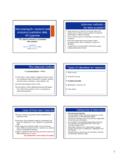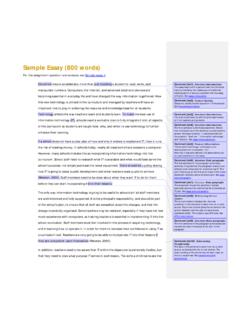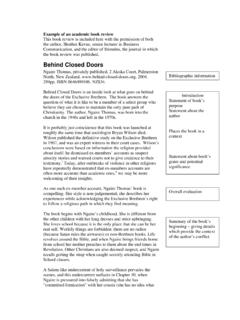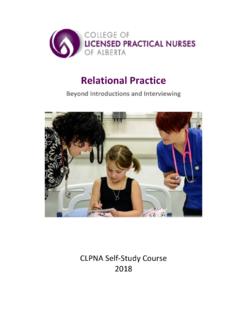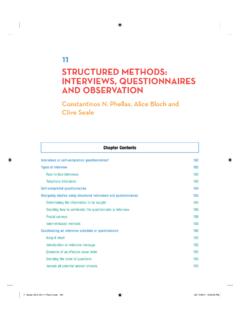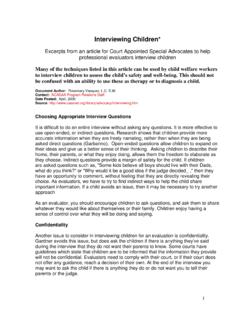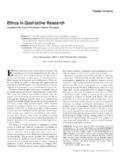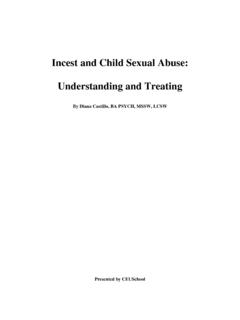Transcription of Interview methods – Interviewing for research and
1 1 Interviewing for research and analysing qualitative data: An overview(revised May, 2011) The Interview method is a conversation with a purpose Martin WoodsSchool of Health & Social ServicesMassey UniversityInterview methods for what purpose? Large amounts of relevant information about the experiences of others may be collected by directly questioning or talking to people. Some research questions are better answered in such Some research questions are better answered in such a fashion. Interviews, especially unstructured or semi-structured ones, offer considerable researcher flexibility.
2 A great deal of research within at least the social sciences depends on them!The Interview non-experimentalin Interview is used widely to supplement and extend our knowledge about individual(s) thoughts, feelingsour knowledge about individual(s) thoughts, feelings and behaviours, meanings, interpretations, etc. One of the best ways to achieve interviewer collects detailed personal information from individuals usually in one to one situations using oral questions. Types of interviews for research1) Brief survey2) Extensive survey3) In-depth interviews4) Monologue, narrative, etc5) Case of Interview materialsInterview material may provide either quantitative or qualitative argue that quantitative data is considered to be easier to analyse and more reliable than qualitativeeasier to analyse and more reliable than qualitative data.
3 Others argue that qualitative data is less structured, more difficult to analyse but the results are as valid as those in quantitative research . However, qualitative data may help to explain some very difficult questions or presentation covers mainly this of interviews1. The structured Interview The key feature of the structured Interview is in the pre-planning of all the questions asked. Structured interviews also allow for exact replication of the Interview with others. To an extent, it is possible to generalise what youTo an extent, it is possible to generalise what you find out about the population from which your Interview sample came.
4 Structured interviews are conducted in various modes: face-to-face, by telephone, videophone and the Internet. Questionnaires and surveys are common examples of structured Interview the semi-structured Interview A key feature of the semi-structured Interview is in the partial pre-planning of the questions. Semi-structured interviews still allow for replication of the Interview with others, but are be less controlled. Semi-structured interviews may be conducted in yvarious modes: face-to-face, by telephone, but face-to face is probably best.
5 A great deal of qualitative research (grounded theory, thematic analysis, etc) uses semi-structured Interview material).The semi-structured Interview :benefits and disadvantages The primary advantage of in-depth interviews is that they provide much more detailed information than what is available through other data collection methods , such as surveys. Standardisation of at least some of the questions increases data Standardisation of at least some of the questions increases data reliability. Replication possible. Ability to ask some spontaneous questions is sensitive to participants need to express also may provide a more relaxed atmosphere in which to collect information people may feel more comfortable having a conversation with you as opposed to filling out a survey.
6 Limitations of in-depth interviews The use of an occasional spontaneous question makes the answers difficult to quantify and analyse. Spontaneous questions asked of some and not of others can be seen as unfair, or possibly misleading. Can be time-intensive Can be time-intensive The interviewer must be capable of performing reliable interviews Not generalisable Prone to possible bias Pre- Interview preparationPlanningIdentify likely participants to be an adequate sample size if research will follow international and national ethical research standards, including review by ethical research committees.
7 Pre- Interview IIDeveloping What to say to interviewees when setting up the Interview ; What to say to interviewees when beginningthe Interview - including ensuring informed consent and confidentiality of the intervieweeand what to say toconfidentiality of the interviewee and what to say to interviewees in concludingthe Interview ; What to do during the Interview ( take notes, audiotape, etc); What to do following the Interview ( more notes and/or check audiotape for clarity; perhaps summarize key thoughts). Stages of an interviewThere are at least five stages:1.
8 Arrival It d tiIntroductions, background noise checks, getting to know each other, Setting up audiotape/ recording equipment, settling down, the researchExplain: the purpose of the Interview , why the participant has been chosen, and the expected duration of the iSeek informed consent of the interviewee: Use the information sheet, explanation of how the information is confidential, etc., the use of note taking and/or the tape recorder, written or documented oral consent. If the interviewee has consented, conduct the the interviewGradually, unhurried, open-ended questions.
9 Semi-structured Although you should have some pre-planned questions to ask during the Interview , you must also lltit fltllbdallow questions to flow naturally, based on information provided by the respondent. Do not insist upon asking specific questions in a specific order. In fact, the flow of the conversation dictates the questions asked, and those omitted, as well as the order of the to remember when interviewingThe interviewer: must make the interviewee comfortable. appear interested in what they are saying.
10 Avoid yes/no and leading questions. Use appropriate body language. Keep personal opinions in to avoid when Interviewing Biased questions: Questions that assume what they ask: Double-barrelled questions: Questions that do not directly relate to what you want to find out: Confusing or complicated questions:4. Keeping focussed: More Interview tipsQuestions should be open-ended rather than closed-ended. You should usually ask a factual question before an opinion question. Use probing questions as These include: Would you give me an example?
